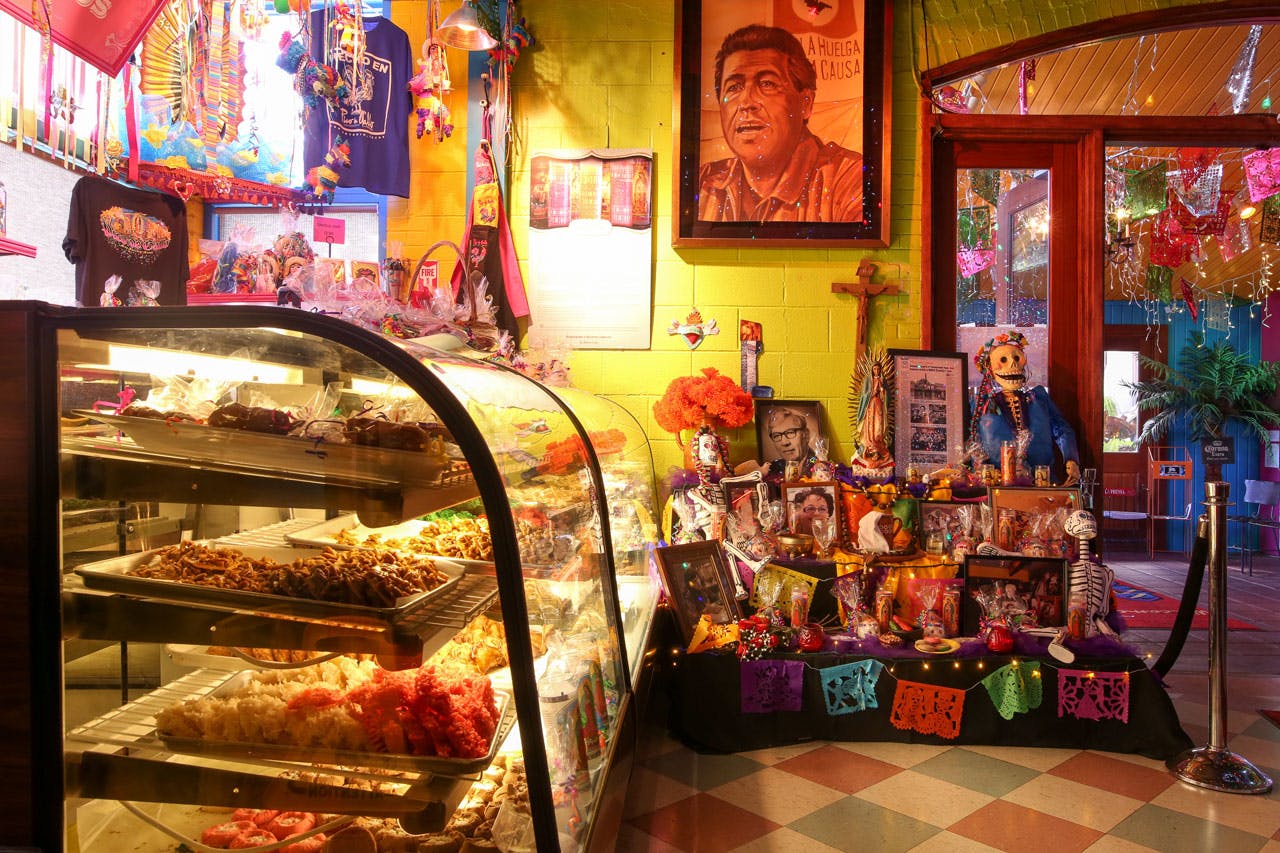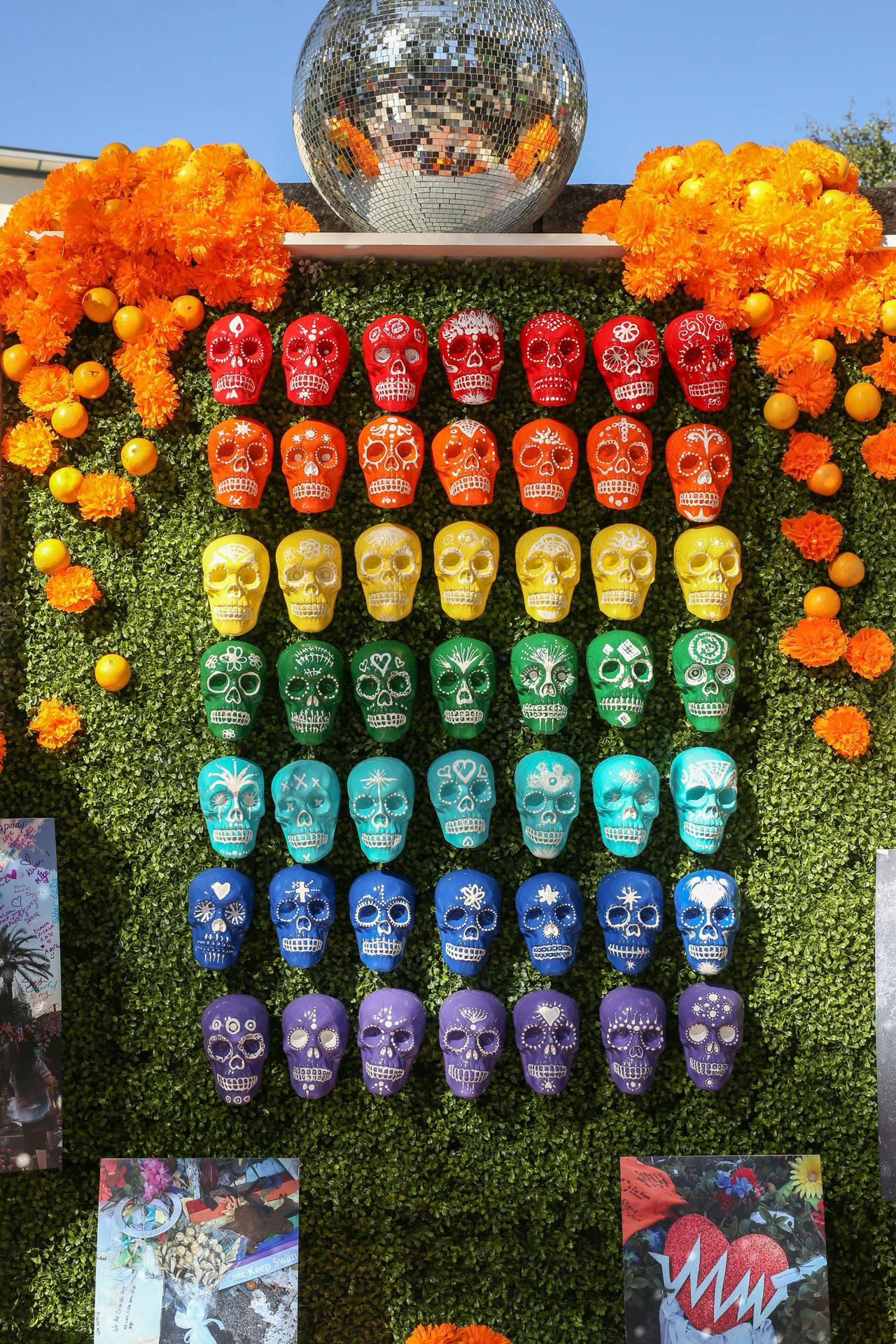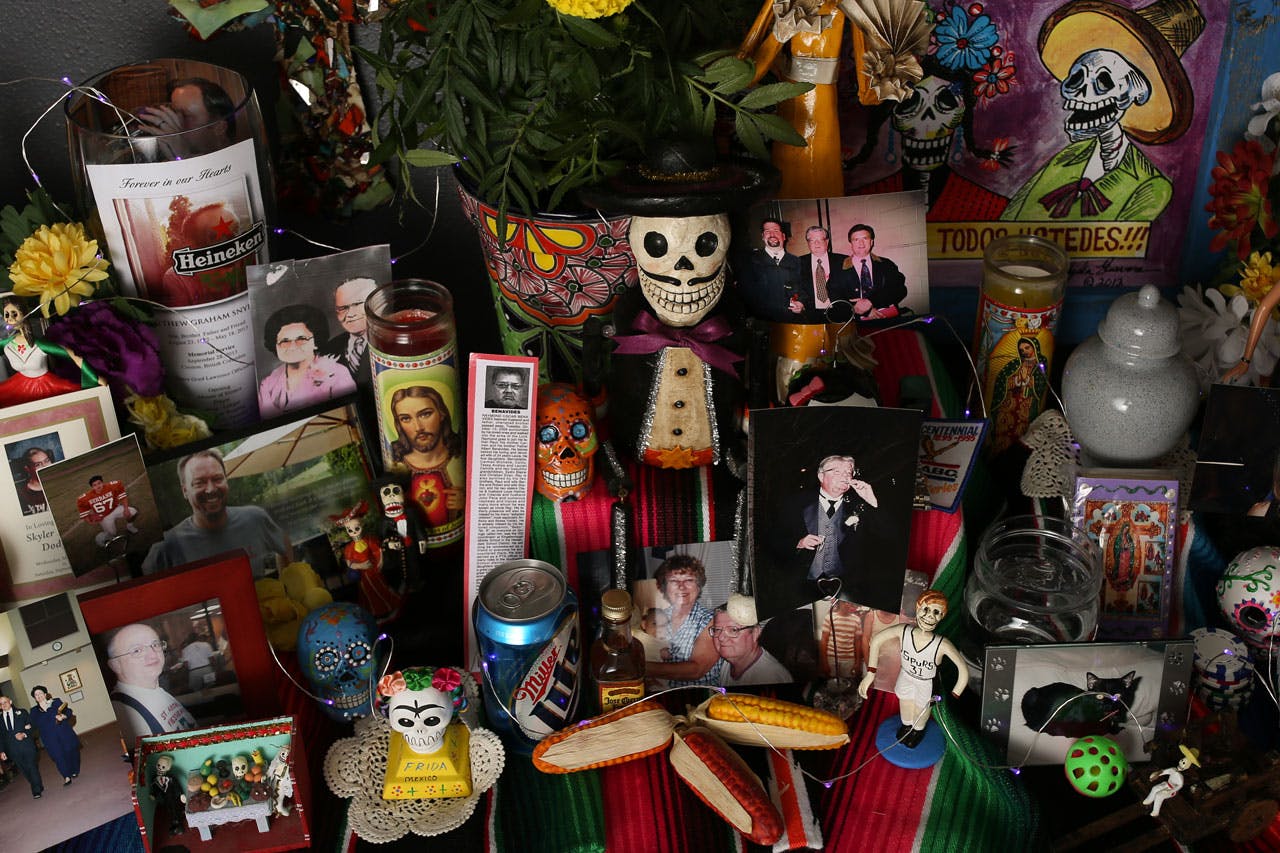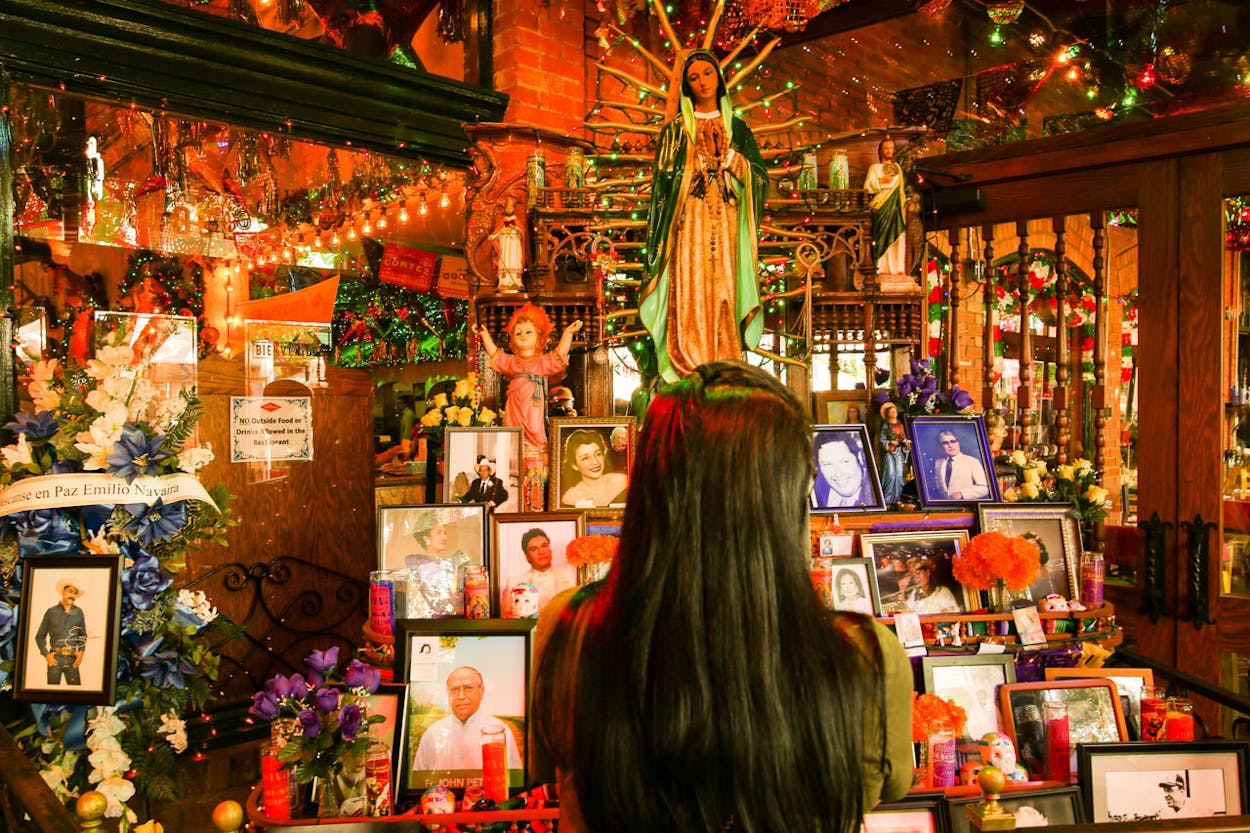Through assorted photographs, trinkets, and belongings, the dead come alive each November. Every year on All Souls Day, or día de los muertos, people build ofrendas, decorated altars meant to memorialize deceased loved ones. Copal incense and velas burn, the hypnotic scent meant to guide those souls back to the land of the living. There, they are greeted with their favorite foods, water to quench their thirst, and the scent of marigolds or cempazuchitl, the traditional flower of the dead—all offerings for the spirits to enjoy during their brief return to Earth.
This tradition originated in Mexico and is now celebrated in countries all over the world, including here in Texas. Below are six altars built by people in San Antonio as a way to remember the ones who are gone but never forgotten.
Deborah Cortez: Mi Tierra Café and Restaurante Pico de Gallo

The Cortez family owns several restaurants in San Antonio, Mi Tierra and Restaurante Pico de Gallo, both in Market Square area. For years, they have set up altars at each location, some that stay up year-round, and others that are temporary. But at each restaurant is a tribute to their founder Pete Cortez and the lasting vision he imparted when he founded Jamaica Café in 1941, a humble three-table restaurant that grew into the always-bustling Mi Tierra.
For me, space is sacred. When we create altars, it’s about creating a familiar place. I feel my way through it. I allow the space to reveal itself. Sometimes, I don’t understand, but I’ve learned to follow that.
Over the years, a lot of customers are at home here. Maybe they met their spouse here, or celebrated after a baptism or they come for coffee everyday. They become part of our family. So when someone in their family departs, they want to put photographs on our altars. A lot of the photographs are from people who spent their lives here.

I put photographs of people who were with my grandfather from the beginning when he founded our organization and now some of our patrons and our employees are on the altar as well. It’s overtaken with pictures.
You’ll see my grandfather on most of the altars at Mi Tierra to honor him. He was brought here by my Tia Justina [his great aunt]. She had a grocery store nearby and that’s where he worked. He would deliver down toward the Mercado area [where Market Square is now] and on that route is where he met my grandmother.
He loved that Mercado area so much even though it was in the most depressed state. It was in one of the worst areas of the city; urban renewal was going to knock it out. They said it wasn’t even fit for animals, much less human beings. But when he saw it, he had to put his flag. He started with one little three-table restaurant in 1941 and in ’51 he had Mi Tierra.
He’s sill here. I talk to him all the time. If we’re fighting I have to tell him. If I need help, I’ll ask him what to do.
Jennifer Rodriguez and Juan Martinez Jr.: Nicole Martinez

Nicole Martinez was a strong, spirited member of the Martinez family—she knew how to live. After her death in June, her family banded together, building her altar at La Villita, so the public could share in their memories of Nicole.
Jennifer Rodriguez: My cousin Nicole passed away from cancer June 17. She was 29.
I’m the oldest of the grandchildren, and we’re all very close. We lived next door to each other. After she passed, I told my mom, “I got to see when they brought her home, and I got to see her go.”
We used to do everything together. We were more like sisters. All us girls were the same: strong, independent women with a lot of attitude. I was rough with all of them growing up because I wanted them to be strong. Seeing her go through her cancer—she was the strongest person I know. I didn’t teach her that, she taught me.
This is the first year we’re celebrating [día de los muertos]. It’s emotional. On the cross I’m going to have a slideshow from when she was a baby to her last days.
We made her altar very colorful and cheerful because that’s the kind of person she was. There’s a vase with sand from Corpus Christi—it’s the last trip that we took together before she passed away. There are pictures of her and her three kids, her best friends, her fiancé. We have her favorite things: Nicha’s margaritas, Bud Light, and we have a jalapeño because she ate them with everything.
I wanted everybody to celebrate her life like we did and get to know her through the altar.
Juan Martinez Jr. : She was my wonderful daughter. She’s the oldest of my four girls.
She used to live right next door to me. Me and her would be loving, fighting, not talking for one day or two days, and then the next day we’d love each other again.
We’ve gone through some real bad things this year and last year. She went, and last year was my mom. It was two hard hits at once.
This is all about remembering her, every single second, never letting her go. There’ll be no more arguments, just good memories. We’re a very close family and I feel like this is going to get us closer than we’ve ever been before.”
David Garcia: Pulse Nightclub Altar

For seven years, David Garcia called Orlando home. There he found a community of friends in nightclubs like Pulse, the scene of a horrific mass shooting on June 12, 2016. Garcia was already living in San Antonio when the incident occurred, but after returning to Orlando several times since then, he knew he wanted to find a way to honor the 49 people who were killed.
It was a safe place. You went there with the intention of socializing with friends and not having to worry about the negativity of the world. Every Tuesday was $2 martinis and that was about being young and broke and being with your friends who you considered family. It was not something you would ever imagine would amount into something so devastating.
This could happen to anyone, anywhere, and unfortunately, this was a minority group that was targeted because they were gay. In this day and age, you just can’t live your life hating and resenting people because of who they are. Hearing the news back in June was really shocking and disturbing, and it hit very close to home.
Some of the people that were involved were acquaintances or friends of people I know. Having to see friends go through the process of grieving and not having it be just one funeral that week, but three—it was very intense. When I went and photographed [the memorial] we broke down. Just the feeling of being there weighs heavy on your heart.
I was just there about three weeks ago and it’s just amazing to see how what happened changed everything—there’s a big sense of camaraderie there.
On that last trip, I was just inspired. When we decided to do the altar, I thought we could design something tangible that we could donate on our trip to Orlando Pride.
There are 49 hand-painted skulls to represent the victims, Florida oranges as an offering to the deceased, the lights from the disco balls to represent their sprits, and in the background you hear Sia’s “The Greatest,” which she did as a tribute to the victims.
When people see it, I just hope they come away with an appreciation for life.
Stephanie Mihleder: Zapata-Mihleder Family Altar

Every October, Stephanie Mihleder pores over albums of photographs with her daughter Carmen, choosing the pictures that will go on their family altar. Toward the end of the month, friends and family celebrate día de los muertos with them, sharing their own memories of loved ones in a ceremony led by the children, who will hopefully carry it on.
My grandfather was the rock of our family. He’s the reason we started this.
He was a stern, very traditional Mexican man. But as he got older, he got soft. We would sit on the couch and watch every cowboy movie together. I hated them, but it was cuddle time. He was really sick and we would watch Walker, Texas Ranger together.
My daughter never knew him. He died before she was born. We wanted to start a tradition to keep the memories and stories alive. We put [the altar] up in the beginning of October, and every day Carmen will ask who someone is or a memory about them.
Like when I first met my father-in-law, we were at a pool hall, and he goes, “You shoot pool little girl?” And when I said no, he said, “Well, you better learn if you’re going to be a part of this family.” He and my husband taught me how to shoot pool. We called him “Old Man Chuck,” and he was a lot of fun. Carmen was three months old when Grandpa C passed away so she just knows him from this picture [on the altar.]
It allows us to talk about it and tell her things like how he loved to hold her. It’s important for her to make that connection.
We wanted to start a tradition and find ways to make this important to her. She’s an only child, so if she doesn’t do it, no one will.
She didn’t know half of these people. But when she leads our ceremony, by the end of the night everyone will have put up their own pictures and the altar will be covered. My grandmother will bring cut marigolds for each person, so as we go around the room everyone will come up and say a memory and put the flower in a vase.
People pass and it’s sad, but we’re remembering the joy they brought.”
Pat Jimenez

San Antonio-based artist Pat Jimenez began building an altar two years after her father’s death. As the years went by, she began including her husband’s family members and teaching her nieces and nephews about the importance of remembering the dead.
Tradition is who we are. We see a little bit of ourselves in each of our ancestors whether it’s in their culture or their customs. It’s something that was part of your family that was ingrained in you.
When we celebrate, my siblings and I tell stories and speak about our families so the next generation hears stories they’ve never heard before. It becomes very special. It’s a way of passing off the torch to them. My mom passed this tradition on to me, and now I’m passing it on to the younger kids.
She died in 1990 and my dad died in ’93. It was probably about 1995 that I started making an altar, and I’ve done it every year since. It was bittersweet. It was good to celebrate their lives, but at the same time, you never get over it. It was like yesterday. When I look at these pictures, I remember the exact time they were taken.
I remember when my dad sat outside on the patio and was singing with his guitar. He tried to sing, but just wasn’t that good. He had such a sense of humor though.
Every year I get choked up, and they’ve been gone nearly thirty years. It helps me to remember them when I look at the pictures. I think about them a lot every day, but I remember these specific memories.
I came across this little stamp of a Woodie car, those little SUVs with wood paneling. When I was a kid, my dad became an auto car salesman and we had a different car every week. I remember him bringing the Woodie home and thinking we’d all fit nice and comfortably. We opened the doors and there were no back seats, but my father said, “Not to worry,” and brought a picnic table to put in the back seat. We were holding on as the bench was going back and forth in the car just laughing.
All these little things bring back such good memories.
Diana Martinez: S.O.L.O.S. Altar

Founded in 1987, S.O.L.O.S. (Survivors of a Loved Ones Suicide) is a support group for those who have lost friends or family members to suicide. The group created an altar for día de los muertos to raise awareness about suicide and break down the stigma surrounding the subject.
I lost my boyfriend Jack to suicide ten years ago.
We were high school sweethearts. We met in English class in eleventh grade. He was the kind of guy that walked in to class and had a leather jacket on. He was the cool guy—strong, silent, understated, and really smart.
Honestly, he did drink and smoke, but he would go to extremes. There was one summer before senior year where he had taken his mother’s medication and he had to be hospitalized. I remember taking the bus down every day to visit him. I asked him why he had done it and he just said, “I was just looking for a different kind of high.”
I was so young and naive, I believed him.
When he bought the gun, he said it was for fun.
It was so weird to me, but then again, I like to do archery. I thought it was something similar. I never touched that gun. But sure enough, that’s what he used.
We weren’t living together, and I had just gotten back home [from Florida] and seen him briefly. The next morning, I couldn’t get ahold of him and I just had this horrible gut feeling.
My sister met me at his apartment. She knew I was really upset and we walked in together. She went to the kitchen and I went to the bathroom and I found him there.
Honestly, it wasn’t such a gruesome sight. I just saw him in the bathroom and turned around. He was face down on the floor, wearing all black. It was so surreal seeing him like that.
Suicide is such a different type of death. A lot of people experience guilt and that’s something I had to deal with for so many years. There’s still a lot of ignorance surrounding it. When I went to therapy, my therapist found the SOLOS group. It was a small group about eight to twelve people. I just cried. I did the ugly cry at every meeting for at least a solid year. In the support group, they understand exactly what you’re going through.
Doing this altar, my heart and soul went into it. I didn’t want to use the traditional altar set up; I wanted to educate people and take away some of the stigma.
- More About:
- Art
- San Antonio








